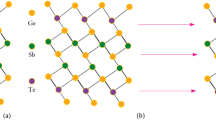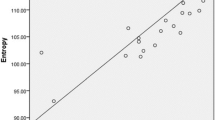Abstract
Two-dimensional materials have fascinated extensive attention due to their novel optical and mechanical properties for prospective applications. In (QSPR/QSAR) studies, the biological activity of underlying structure is associated with physical properties of structure by using topological indices. A huge spectrum of topological indices is available, among which the degree-based indices are used in this study. These indices have substantial iteration with the total \(\pi \)-electron energy. Moreover, we measure the graph entropies to obtain the structural information of two-dimensional trans-Pd–\(({\mathrm{NH}}_{2}){\mathrm{S}}\) lattice and a metal–organic superlattice.










Similar content being viewed by others
References
D. Bonchev, Complexity in Chemistry, Introduction and Fundamentals (Taylor and Francis, Boca Raton, 2003)
Z. Chen, M. Dehmer, Y. Shi, A note on distance based graph entropies. Entropy 16, 5416–5427 (2014)
S. Cao, M. Dehmer, Y. Shi, Extremality of degree-based graph entropies. Inf. Sci. 278, 22–33 (2014)
C. Chakravarty, B. Mandal, P. Sarkar, Coronene-based metal–organic framework: a theoretical exploration. Phys. Chem. Chem. Phys. 18(36), 25277–25283 (2016)
M. Dehmer, Information processing in complex networks: graph entropy and information functionals. Appl. Math. Comput. 201, 82–94 (2008)
M. Dehmer, L. Sivakumar, K. Varmuza, Uniquely discriminating molecular structures using novel eigenvalue-based descriptors. MATCH Commun. Math. Comput. Chem. 67, 147–172 (2012)
M. Dehmer, A. Mowshowitz, A history of graph entropy measures. Inf. Sci. 181, 57–78 (2011)
M. Dehmer, M. Graber, The discrimination power of molecular identification numbers revisited. MATCH Commun. Math. Comput. Chem. 69, 785–794 (2013)
W. Gao, M.K. Siddiqui, M. Naeem, N.A. Rehman, Topological characterization of carbon graphite and crystal cubic carbon structures. Molecules 22, 1496–1507 (2017)
W. Gao, M.R. Farahani, Degree-based indices computation for special chemical molecular structures using edge dividing method. Appl. Math. Nonlinear Sci. 1(1), 94–117 (2015)
M. Imran, M.K. Siddiqui, M. Naeem, M.A. Iqbal, On topological properties of symmetric chemical structures. Symmetry 10(173), 1–21 (2018)
T. Kambe, R. Sakamoto, K. Hoshiko, K. Takada, M. Miyachi, J.H. Ryu, H. Nishihara, \(\pi \)-Conjugated nickel bis (dithiolene) complex nanosheet. J. Am. Chem. Soc. 135(7), 2462–2465 (2013)
S. Manzoor, M.K. Siddiqui, S. Ahmad, On entropy measures of molecular graphs using topological indices. Arab. J. Chem. 13(8), 6285–6298 (2020)
A. Mehler, Lücking, A., & Weib, P., A network model of interpersonal alignment in dialog. Entropy 12(6), 1440–1483 (2010)
H. Morowitz, Some order-disorder considerations in living systems. Bull. Math. Biophys. 17, 81–86 (1953)
A. Mowshowitz, M. Dehmer, Entropy and the complexity of graphs revisited. Entropy 14, 559–570 (2012)
H. Quastler, Information theory in biology. Bull. Math. Biol. 18, 183–185 (1954)
N. Rashevsky, Life, information theory, and topology. Bull. Math. Biol. 17, 229–235 (1955)
C.E. Shannon, A mathematical theory of communication. ACM SIGMOBILE Mob. Comput. Commun. Rev. 5(1), 3–55 (2001)
C.E. Shannon, A mathematical theory of communication. Bell Syst. Tech. J. 27, 379–423 (1948)
D. Sheberla, L. Sun, M.A. Blood-Forsythe, S. Er, C.R. Wade, C.K. Brozek, M. Dinca, High electrical conductivity in Ni\(_3 (2, 3, 6, 7, 10, 11\)-hexaiminotriphenylene) 2, a semiconducting metal–organic graphene analogue. J. Am. Chem. Soc. 136(25), 8859–8862 (2014)
M.K. Siddiqui, M. Imran, A. Ahmad, On Zagreb indices, Zagreb polynomials of some nanostar dendrimers. Appl. Math. Comput. 280, 132–139 (2016)
M.K. Siddiqui, M. Naeem, N.A. Rahman, M. Imran, Computing topological indicesof certain networks. J. Optoelectron. Adv. Mater. 18(9–10), 884–892 (2016)
Z. Shao, J. Amjadi, S.M. Sheikholeslami, M. Valinavaz, On the total double Roman domination. IEEE Access 7, 52035–52041 (2019)
Z. Shao, M. Liang, X. Xu, Some new optimal generalized Sidon sequences. Ars Comb. 107, 369–378 (2012)
Z. Shao, P. Wu, X. Zhang, D. Dimitrov, J.B. Liu, On the maximum ABC index of graphs with prescribed size and without pendent vertices. IEEE Access 6, 27604–27616 (2018)
R.V. Sol, S.I. Valverde, Information theory of complex networks: on evolution and architectural constraints. Complex Netw. Lect. Notes Phys. 650, 189–207 (2004)
E. Trucco, A note on the information content of graphs. Bull. Math. Biol. 18(2), 129–135 (1956)
Y.J. Tan, J. Wu, Network structure entropy and its application to scale-free networks. Syst. Eng. Theory Pract. 6, 1–3 (2004)
R.E. Ulanowicz, Quantitative methods for ecological network analysis. Comput. Biol. Chem. 28, 321–339 (2004)
S. Wang, Z. Shao, J.B. Liu, B. Wei, The bounds of vertex Padmakar–Ivan index on k-trees. Mathematics 7(4), 324 (2019)
Q. Zhou, J. Wang, T.S. Chwee, G. Wu, X. Wang, Q. Ye, S.W. Yang, Topological insulators based on 2D shape-persistent organic ligand complexes. Nanoscale 7(2), 727–735 (2015)
Author information
Authors and Affiliations
Corresponding author
Rights and permissions
About this article
Cite this article
Manzoor, S., Siddiqui, M.K. & Ahmad, S. On physical analysis of degree-based entropy measures for metal–organic superlattices. Eur. Phys. J. Plus 136, 287 (2021). https://doi.org/10.1140/epjp/s13360-021-01275-5
Received:
Accepted:
Published:
DOI: https://doi.org/10.1140/epjp/s13360-021-01275-5




